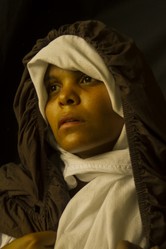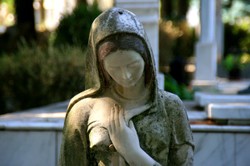Imagine.Night time in an Indian town. But there is a house that does not sleep, or rather, whose occupants snatch slumber between clients. But the comings and goings have been noticed, Someone has whispered to the nuns that there are slave girls inside. The nuns quietly gather what evidence they can. Satisfied that there is something wrong, they contact the police, who greatly value the sisters' work.
The police strike quickly so as to prevent the traffickers from getting their slaves out of the way. As the police cars surround the building and the armed officers burst inside, the two women in the rear seats of one car put their rosary beads into their bags and are escorted indoors. The sisters of Amrat, India's network of antislavery nuns, are beginning a long night gathering evidence, interviewing girls and giving emotional support to girls who often burst into tears on their liberation. In many areas the police greatly value these Catholic nuns' expertise and take them on raids because of the quality of the evidence that they can provide.
Let us take an imaginary, though fully typical young slave girl. She is sixteen and was raised in a remote village. She was not doing well at school, so her prospects were low. Indira, that's what I will call her, met some charming young men, one of whom gave her a mobile phone and bought her gifts. Then he persuaded her to give up school and follow him to the city, where a comfortable and prosperous life awaited her. Slipping off with him was her greatest mistake, for her dreams turned to nightmares as she found herself trapped into slavery. Her parents reported her missing, but in the overpopulated cities of India one missing girl will not be noticed. But Amrat have made a note of her name and placed her on their database. The aim is to get Indira protected, healed, and home, hopefully to resume her life and education.
Amrat is not a conventional NGO [non-governmental organisation] for it has limited bureaucracy and relies not so much on states, but on the organisational structure of the Roman Catholic Church. While most NGOs are town based, as you would expect from organisations linked to governmental structures, Amrat extends out into the villages.This means that it can encounter vulnerable people who might otherwise slip the net. A key part of its role is education for prevention, informing often naive, under-educated, impoverished people of the dangers that lurk to prey on vulnerable young girls [and boys] at the hands of seducers brandishing cash and deceptive inducements.
While Amrat is exclusively Indian, it is an element in a global religious women's network that is doing wonderful work quietly and without any thought of personal gain.







 Pilgrimage. A reviewon 06/15/2025
Pilgrimage. A reviewon 06/15/2025
 Leo the Fourteenthon 05/09/2025
Leo the Fourteenthon 05/09/2025
 The Melsonby Hoardon 03/25/2025
The Melsonby Hoardon 03/25/2025




Comments
Probably petrol powered
Thank you for your comment below in answer to my previous observation and question.
Unitedstatesian motor scooters can be gas-driven or operated by periodically picking up speed by running one foot on the ground.
Which do motor-scootering sisters drive?
(Is there such a thing as a solar-energy motor-scooter option for them?)
It varies. Ideally they will have some inexpensive mode of transport, such as a motor scooter at their disposal.
Thank you for your comment below in answer to my previous observation and question.
The third paragraph to the second subheading, Hard work, advises us that "Often the sisters have to travel long distances to reach a village, and with the transport that they have available the sisters start early and finish late."
Do the Amrat sisters travel by private or public or both transportation means?
They have their own contents.
Thank you for your comment below in answer to my previous observation and question.
The Amrat sisters appear to be a committed, tight-knit team. Do they operate from a particular convent or do they reside, grouped or individually, elsewhere?
Of course, private charity has its place.
Thank you for your comment below in answer to my previous observation and question.
Your answer indicates "other sources, such as the state, help." Is there such a thing as private contributions?
The church runs them in co-operation with the state. Funding comes from church charitable funds, but other sources, such as the state,help. The state provides protection.
frankbeswick, Thank you for the back- and front-stories about Amrat and for the products. Are the rescue centers, for those rescued but not assured of safe returns home, run by the Church, the community, the government or the sisters?